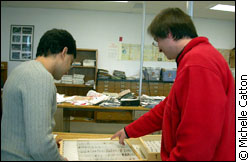| Identity
theft: investigating fraud in nature
By Michelle Catton
 |
| If it looks like a bee, and
sounds like a bee, there's a good chance it's a
hoverfly. Tom Sherratt's research team investigates
mimicry in nature. |
OTTAWA —
Tom Sherratt’s evolutionary
biology research lab at Carleton University doesn’t
look very exciting. There are no researchers in white
lab coats making detailed notes on their clipboards.
There are no Petri dishes or microscopes or impressive
diagnostic machines with blinking lights. There isn’t
an animal specimen in sight; not one primate or reptile
or insect being probed.
Empty tables fill the room, three computers
line one wall, and a shelf littered with books, journals
and manuscripts occupies another. But looks can be deceiving.
According to Sherratt, his team is examining
and clarifying evolutionary theory first presented by
Darwin — the grandfather of evolution himself.
They are studying the natural phenomenon of mimicry.
“The study of mimicry has influenced
evolutionary thought perhaps more than any other subject,”
says Sherratt.
In nature, imitation is not only the
sincerest form of flattery, it is sometimes the best
way to compete for survival.
» Full
Story
|